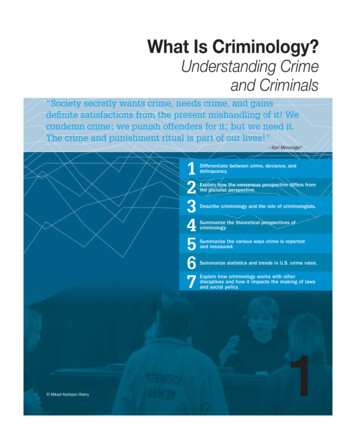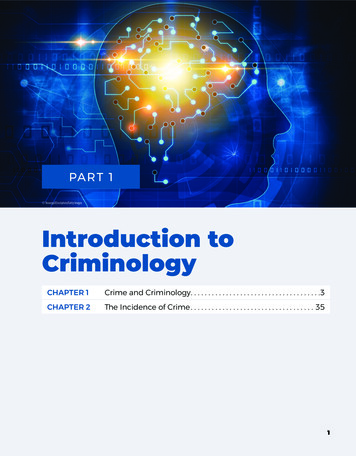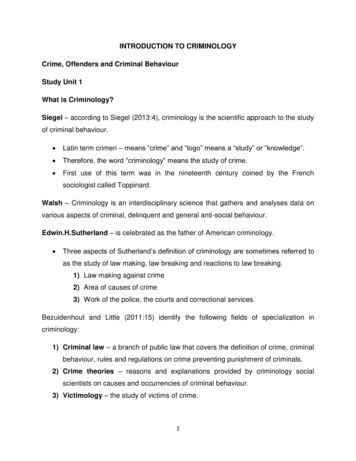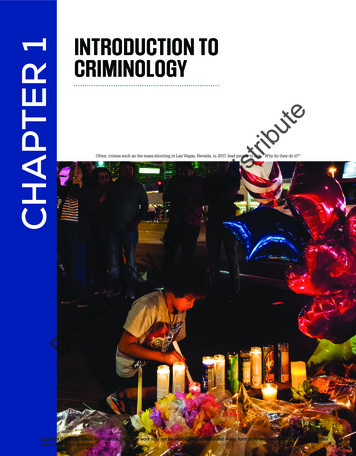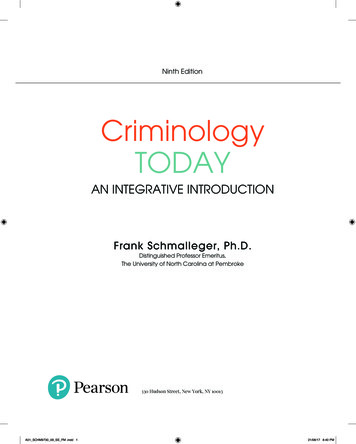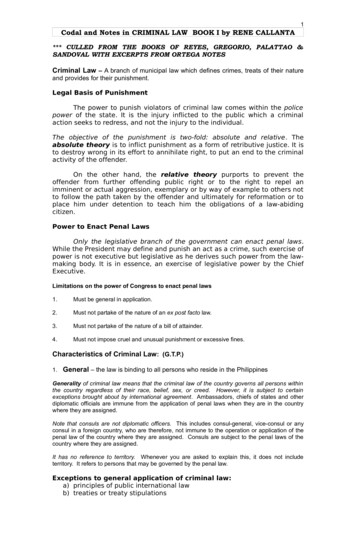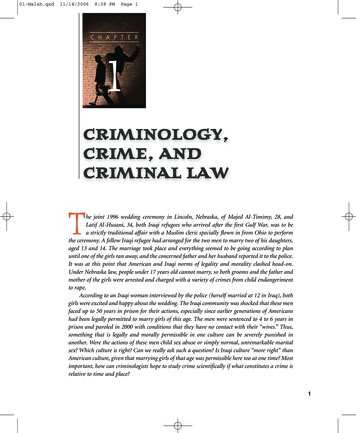
Transcription
01-Walsh.qxd11/14/20068:38 PMPage 1C H A P T E R1CRIMINOLOGY,CRIME, ANDCRIMINAL LAWThe joint 1996 wedding ceremony in Lincoln, Nebraska, of Majed Al-Timimy, 28, andLatif Al-Husani, 34, both Iraqi refugees who arrived after the first Gulf War, was to bea strictly traditional affair with a Muslim cleric specially flown in from Ohio to performthe ceremony. A fellow Iraqi refugee had arranged for the two men to marry two of his daughters,aged 13 and 14. The marriage took place and everything seemed to be going according to planuntil one of the girls ran away, and the concerned father and her husband reported it to the police.It was at this point that American and Iraqi norms of legality and morality clashed head-on.Under Nebraska law, people under 17 years old cannot marry, so both grooms and the father andmother of the girls were arrested and charged with a variety of crimes from child endangerimentto rape.According to an Iraqi woman interviewed by the police (herself married at 12 in Iraq), bothgirls were excited and happy about the wedding. The Iraqi community was shocked that these menfaced up to 50 years in prison for their actions, especially since earlier generations of Americanshad been legally permitted to marry girls of this age. The men were sentenced to 4 to 6 years inprison and paroled in 2000 with conditions that they have no contact with their “wives.” Thus,something that is legally and morally permissible in one culture can be severely punished inanother. Were the actions of these men child sex abuse or simply normal, unremarkable maritalsex? Which culture is right? Can we really ask such a question? Is Iraqi culture “more right” thanAmerican culture, given that marrying girls of that age was permissible here too at one time? Mostimportant, how can criminologists hope to study crime scientifically if what constitutes a crime isrelative to time and place?1
01-Walsh.qxd211/14/20068:38 PMPage 2CRIMINOLOGY: AN INTERDISCIPLINARY APPROACHyWhat Is Criminology?If the content of the news and popular television shows is any indication, most of us are wildlyinterested in the subject matter of criminology. In the past few years, we have sat transfixed asKobe Bryant, Martha Stewart, and the BTK killer flashed across our television screens, andshows such as Law & Order, NYPD, Cops, and CSI: Miami have sent many a student on a searchfor a course in criminology. There is something about the dark side of human nature thatfascinates us all, and crime and criminal behavior are certainly on the dark side. Criminologyis an interdisciplinary science that gathers and analyzes data on crime and criminal behavior.As with all scientific disciplines, its goal is to understand the phenomena that it studies andto use that understanding for the benefit of humankind. In pursuit of this understanding,criminology asks questions such as the following: Why do crime rates vary from time to time and from culture to culture?Why are some individuals more prone to committing crime than others?Why do crime rates vary across different ages, genders, and racial/ethnic groups?Why are some harmful acts criminalized and not others?What can we do to prevent crime?When we say that criminology is the scientific study of crime and criminal behavior, wemean that criminologists use the scientific method to try to answer the questions they ask ratherthan simply speculate about them from their armchairs. The scientific method is a tool for winnowing truth from error by demanding evidence for one’s conclusions. Evidence is obtained byformulating hypotheses derived from theory that are rigorously tested with the data at hand.Although most contemporary criminologists have been trained primarily in sociologyand criminal justice, there is a growing realization (perhaps even a consensus) that criminology is an inherently interdisciplinary field.1,2 Scientists from many disciplines other than sociology, such as anthropology, biology, economics, and psychology/psychiatry, have contributedgreatly to criminology, but there has been reluctance among some criminologists to acceptand integrate findings from them into their understanding of crime.According to a growing number of prominent criminologists, there is something of acrisis in criminology.3,4 A subset of them considers the crisis to be a function of the failureto recognize the contributions of the more fundamental sciences such as genetics, physiology,neurophysiology, endocrinology, and evolutionary biology. Some have even called for suchrecognition in the context of their presidential addresses to the American CriminologicalSociety5–8 and the Academy of Criminal Justice Sciences.9The failure to incorporate these sciences is unfortunate because philosophers of sciencehave long maintained that the only route to progress in any science is to integrate insights fromthe more advanced adjacent sciences.10,11 Chemistry advanced when it dropped its oppositionto the intrusion of physics and its “newfangled” ideas about something called atoms in the late19th century. Biology took enormous strides when it dropped its opposition to the intrusion ofchemistry in the mid-20th century after the discovery of the structure of DNA, and psychologyhas come a long way since more fully embracing biology. In fact, the core concepts of these disciplines (ions in chemistry and genes in biology) came from disciplines previously discountedas irrelevant. A very interesting history surrounds the initial opposition of these sciences totheir “antidisciplines” and their eventual acceptance of them,12 but we can’t get into that here.
01-Walsh.qxd11/14/20068:38 PMPage 3Chapter 1 Criminology, Crime, and Criminal LawA prominent inscription on a prominent wall at the Massachusetts Institute of Technology(MIT) reads, in part, as follows: “Many of the most important discoveries of the future will comefrom those wise enough to explore the unknown territories between different disciplines.”13 Webelieve that the time has come to present approaches that do this more fully in an introductorytextbook. This text is still primarily sociological in orientation because sociologists have conducted the vast majority of theorizing and research in criminology. It is also primarily sociological in orientation because no matter what insights other sciences may provide criminologists,criminal behavior always takes place in a social context, and the perspective from which mostcriminologists work is sociological.yWhat Is Crime?What sort of person comes to mind when you hear the word criminal? The term can beapplied to many types of behavior, some of which nearly all of us have been guilty of at sometime in our lives. However, very few people ever commit murder, robbery, or major theft.Those who do, especially those who do so repeatedly, are what most people think of as “realcriminals.” Even so, it is important to recognize that the dividing line between “real criminals”and most of the rest of us is fuzzy and difficult to specify with precision. Nearly all of us canthink of acts that we feel ought to be criminal but are not, or acts that should not be criminalbut are. As you can imagine, the roster of possible wrongs that someone or another considerscrimes is enormous, with only a select few being defined as criminal by the law. Furthermore,ask yourself how many crimes would people have to commit before they are considered realcriminals—three, four, or maybe five? Or would the answer depend on how serious eachcrime was? The main purpose of exploring topics such as these is to acquaint you with howcriminologists conceptualize their discipline and what they include and exclude from study.Despite the difficulties attending the definition of crime, we need one to proceed. Perhapsthe most often quoted definition comes from Paul Tappan, who defined crime as “an intentional act in violation of the criminal law committed without defense or excuse, and penalizedby the state.”14 Thus, a crime is an act in violation of a criminal law for which a punishmentis prescribed; the person committing it must have intended to do so and must have done sowithout legally acceptable defense or justification.A fundamental point on which all criminologists agree is that crime is a legal conceptdefined by the political state and its subdivisions. The fact that crime is a legal rather than ascientific concept has implications for the scientific study of crime. Hypothetically, a societycould eradicate crime tomorrow simply by rescinding all of its criminal statutes. Of course,this would not eliminate the behavior specified by the laws; in fact, the behavior would doubtless increase since the behavior could no longer be officially punished. While it is absurd tothink that any society would try to solve its crime problem by eliminating its criminal statutes,legislative bodies are continually revising, adding to, and deleting from their criminal statutes.yCrime as a Moving TargetEvery vice is somewhere and at sometimes a virtue. Numerous examples of acts defined ascrimes in one country are tolerated and even expected behavior in another, such as theexample given at the beginning of this chapter of adult males marrying and being sexually3
01-Walsh.qxd411/14/20068:38 PMPage 4CRIMINOLOGY: AN INTERDISCIPLINARY APPROACHactive with girls as young as 12. Female circumcision (clitorectomy) involving the surgicalremoval of the clitoris is found in many parts of Africa and the Middle East. It is performedon prepubertal girls without anesthetic and has been known to cause death due to infection.15Anyone performing such a procedure in the United States would be charged with child abuseand malicious wounding. Likewise, while many countries have historically regarded abortionas a crime, most democratic countries permit it today. Ironically, many of these same countrieshave laws making it a crime for mothers to drink excessively or take various drugs duringpregnancy because they might harm their unborn infants.16 In several cultures, infanticide(the killing of infants by a parent) is not defined as a criminal act,17 while in other societies,parents can be held criminally liable for failing to take their children for proper medical treatment, even if doing so violates the parent’s religious beliefs.18Laws vary within the same culture from time to time as well as across different cultures.Until the Harrison Narcotics Act of 1914, there were few legal restrictions in the United Stateson the sale, possession, or use of most drugs such as heroin and cocaine. Following theHarrison Act, many drugs became controlled substances, their possession became a crime, anda brand new class of criminals was created overnight. Stalking is hardly novel behavior, butcertain high-profile cases moved the state of California to recognize the dangers inherent inthe practice and to pass the nation’s first antistalking law as recently as 1990.19Crimes pass out of existence also—even acts that had been considered crimes forcenturies by some groups. The private hoarding of gold was a crime in the United States from1934 to 1974, but today it is something of a virtue. Until the U.S. Supreme Court invalidatedsodomy statutes in Lawrence v. Texas (2003),20 sodomy was legally punishable in many states.Most states targeted only homosexual sodomy, but a few extended the reach to include heterosexual sodomy, even between consenting spouses. Likewise, burning the American flag hadserious legal consequences until 1989, when the Supreme Court invalidated anti–flag burningstatutes as unconstitutional in Texas v. Johnson (1989).21 What constitutes a crime, then, canbe defined in and out of existence by the courts or by legislators. As long as human societiesremain diverse and dynamic, there will always be a moving target of activities with the potential for nomination as crimes, as well as illegal activities nominated for decriminalization.If what constitutes crime differs across time and place, how can criminologists hope toagree on a scientific explanation for crime and criminal behavior if the target keeps moving?Science is about making a universal statement about stable or homogeneous phenomena.Atoms, genes, the gas laws, the laws of thermodynamics, photosynthesis, and so on are notdefined or evaluated differently by scientists around the globe according to local customs orideological preferences. The phenomenon we call “crime,” however, keeps moving around, andbecause it does, some criminologists have declared it impossible to generalize about what isand is not “real” crime. For example, Darnell Hawkins has written that “we cannot discoverwhat real crime is, or who the real criminals are.”22What criminologists such as Hawkins are saying is that crime is a socially constructedphenomenon that lacks any “real” objective essence because crimes are defined into existencerather than discovered, although they obviously do not deny the harm underlying the criminal act. At one level, of course, everything is socially constructed; nature does not reveal herself to us, sorted into ready-labeled packages; humans must do it for her. Social constructionmeans nothing more than that humans have perceived a phenomenon, named it, and categorized it according to some classificatory rule (also socially constructed) that makes note of thesimilarities and differences among the things being classified. Most classification schemes are
01-Walsh.qxd11/14/20068:39 PMPage 5Chapter 1 Criminology, Crime, and Criminal Lawnot arbitrary; if they were, we would not be able to make sense of anything. Categories haveempirically meaningful referents and are used to impose order on the diversity of phenomenathat humans experience, although arguments exist about just how coherent that order is. Butthen, few concepts (or constructs) outside of mathematics are defined and understood in sucha way as to make every application of them unproblematic.yCrime as a Subcategory of Social HarmsSo, what can we say about crime? How can we conceive of it in ways that at least most peoplewould agree are coherent and correspond with their view of reality? Criminologist JohnHagan23 has provided a useful way of looking at the definition problem by viewing crime as acontinuous variable and as a subcategory of all harmful acts. Hagan’s definition has threemeasures of harmful acts, ranging from low to high and weak to strong. His first measure isthe degree of consensus or agreement existing in the population about right and wrong acts.Research has consistently shown that there is substantial agreement among average citizensboth within and across modern societies regarding the average seriousness ratings given to avariety of criminal offenses. Studies comparing average seriousness ratings of deviant acts in theUnited States beginning in the 1920s have concluded that rankings have changed only slightly.Among the trends that have been noted both in the United States and other industrial countriesis an increase in seriousness ratings of white-collar crimes compared to ratings of nonviolentstreet crimes, as well as a decrease in seriousness ratings given to most offenses associated with“abnormal” sexual behavior.24 A survey of 3,334 households found remarkably high consensusacross age, gender, race, and socioeconomic status (SES) on the seriousness of 17 differentoffenses.25 On average, this study found about a 96% agreement between citizens of diverse backgrounds about the wrongfulness and seriousness of different crimes. Thus, people everywhereseem to share at least a rough sense of what is acceptable behavior under most circumstances. Inall societies, nearly everyone condemns behavior that intentionally victimizes others, especiallyif the victims are members of the social group to which those making the judgment belong.The second dimension is the severity of the law’s response to a given crime. The more serious the legal penalty, says Hagan, “the more serious the societal evaluation of the act.”26 Thefirst two dimensions are highly correlated, as you would expect. There would be almost unanimous agreement that the bombing of the Murrah Federal Building in Oklahoma City in 1995,which took the lives of 169 people and injured more than 500 others, was wrong. The socialresponse to the perpetrator, Timothy McVeigh, was extremely severe—the death penalty. Onthe other hand, there would be little consensus that smoking marijuana is all that wrong, andthe legal penalties for doing so are weak.The third dimension is the amount of harm caused, a dimension that obviously underliesboth consensus about wrongfulness and severity of legal response—Timothy McVeigh causeda tremendous amount of harm; pot smokers perhaps harm only themselves. Thus, one thingabout crime that is not disputed is that it is a subcategory of harmful acts, most of which arenot regulated by the law.Harmful acts, such as smoking tobacco and drinking to excess, are not considered anyone’sbusiness other than the actor’s if they take place in private or even in public if the person creates no annoyance. Socially harmful acts are acts in a category that some political body hasdecided in nonarbitrary ways are in need of regulation (health standards, air pollution, etc.)but not by the criminal law, except under exceptional circumstance. Radical theorists aver that5
01-Walsh.qxd611/14/20068:39 PMPage 6CRIMINOLOGY: AN INTERDISCIPLINARY APPROACHarbitrariness is more likely to enter the picture when authorities decide not to regulate sociallyharmful behavior, such as racism, sexism, colonialism, harmful business practices, and anynumber of other acts they feel are more harmful than acts that are criminalized. Private wrongs(such as someone reneging on a contract) are socially harmful but not sufficiently so to requirethe heavy hand of the criminal law. Such wrongs are regulated by the civil law in which thewronged party (the plaintiff), rather than the state, initiates legal action and the defendant doesnot risk deprivation of his or her liberty if the plaintiff prevails.Finally, a small subcategory of harmful acts is considered so socially harmful that theycome under the purview and coercive power of the criminal justice system. Even though wehave narrowed down the concept of crime, we are still confronted with the problem of humanjudgment in determining what goes into this subcategory. But this is true all along the line;smoking was once actually considered rather healthy, and air pollution and unhealthy conditions were simply facts of life about which nothing could be done. Categorization alwaysrequires a series of human judgments, but that does not render the categorizations arbitrary.yBeyond Social Construction:The Stationary Core CrimesWe have defined crimes as serious socially harmful acts, but how can we rescue this fromaccusation that even “seriously harmful” is a judgment that moves around across time andspace? We suggest that few people would argue that an act is not seriously harmful if it is universally condemned—that is, if a stationary core of offenses is defined as wrong at almost alltimes and in almost all cultures. Some of the strongest evidence in support of the stationarycore perspective comes from the International Criminal Police Organization (Interpol),27headquartered in Lyon, France. Besides assisting member nations with investigations of international terrorism and organized crime, Interpol serves as a repository for crime statisticsfrom each of its 125 member nations. Interpol’s data show that such acts as murder, assault,rape, and theft are considered serious crimes in every single country. While there are variations in exactly what constitutes each of these offenses, most of them are extremely minor.Criminologists call these universally condemned crimes mala in se (“inherently bad”).Crimes that are time and culture bound are described as mala prohibita (“bad because theyare prohibited”). But how can we be sure that an act is inherently bad? We would say that thelitmus test for determining a mala in se crime is that no one, except under the most bizarreof circumstances (see Focus On . . .), would want to be victimized by one. While millions ofpeople seek to be “victimized” by prostitutes, drug dealers, bookies, or any of a number ofother providers of illegal goods and services, no one wants to be murdered, raped, robbed, orhave their property stolen. Being victimized by such actions evokes physiological reactions(anger, helplessness, sadness, depression, a desire for revenge) in all cultures, and would do soeven if the acts were not punishable by law or custom. Mala in se acts engage these emotionsnot because some legislative body has identified and defined them as wrong; they do sobecause they hammer at our deepest primordial instincts. Evolutionary psychologists proposethat these built-in emotional mechanisms exist because mala in se crimes threatened the survival and reproductive success of our distant ancestors, and they function to strongly motivatepeople to try to prevent such acts from occurring and punish offenders if they do.28–30 In thissense, then, mala in se crimes are very real.
01-Walsh.qxd11/14/20068:39 PMPage 7Chapter 1 Criminology, Crime, and Criminal LawFOCUS ON . . .Mala in Se or Mala Prohibita?The Cannibal and His Willing VictimWe have said that the litmus test for a mala in se crime is that no one would want to bea victim of such a crime. You would think that killing, butchering, and eating anotherhuman being would certainly pass such a test. But what if the cannibal’s dinner was awilling victim and the country in which the cannibal and his victim lived had no law forbidding cannibalism? This strange state of affairs existed in Rotenburg in central Germany in 2001. Germany’sown Hannibal Lecter, one Armin Meiwes, had advertised online seeking volunteers for “slaughterand consumption.” Among the over 200 replies Meiwes received was an e-mail from Bernd-JurgenBrandes stating, “I am your meat.” Meiwes and Brandes (a successful software engineer) videotaped their agreement, and Meiwes taped the subsequent killing and butchering of Brandes.Brandes stated on the tape that being eaten would be the “fulfillment of my dream.”The prosecution in this case argued for a conviction of murder and “disturbing the peace of thedead,” which would have gotten Meiwes a life sentence. The defense argued that what Meiwes haddone was simply to assist Brandes in his suicide, which carried a 5-year sentence. The panel ofjudges hearing the case agreed that Meiwes could not be convicted of murder, split the difference,and handed Meiwes an 8½-year prison sentence in January 2004. Which argument would you havefollowed if you were one of the judges?In common-law countries such as the United States, Meiwes would have been convicted ofmurder because one person cannot give another the consent to kill him or her—you can give yourconsent to many things, but not this. What Meiwes committed was clearly a mal in se crime, andBrandes’s consent doesn’t change that at all. The behavior of both men was obviously bizarre, andjust because we find instances in which people do want to be victimized by acts that 99.9% of theirfellow humans would find repugnant does not change the inherent badness of those acts.SOURCE: Schofield, M. (2004, January 31). German sentenced to 8 and a half years for killing, eating man. IdahoStatesman, p. 3.yVictimful and Victimless CrimesCrimes can also be viewed as arrayed along a victimization continuum and divided intothree crime categories: (1) crimes for which there is an obvious intended victim (e.g., murderand rape), (2) crimes in which victimization is the result of carelessness (e.g., negligentmanslaughter), and (3) crimes in which participation in the crime is voluntary (e.g., prostitution, drug offenses). The distinction between victimless and victimful crimes has to do withharm to an unwilling victim. (There is no standard antonym for victimless to succinctlydescribe a crime having a victim. The term victimful31 has been coined to show that it has thesame relationship to victimless as the term harmful does to harmless.) A victimless crime isconsensual and nonpredatory; a victimful crime is nonconsensual and predatory, and it ismala in se almost by definition.7
01-Walsh.qxd811/14/20068:39 PMPage 8CRIMINOLOGY: AN INTERDISCIPLINARY APPROACH Photo 1.1 In some cities, efforts are made to zone “adult” establishments such as this Tampa stripclub into a specific area. This club features a second floor designed to look like a UFO, where customersare enticed to “blast off” by lap dancing with the strippers. Critics argue that bunching such establishmentsin the same neighborhood adds to the crime problem in the immediately surrounding area.yThe Felony-Misdemeanor DistinctionThe legal concepts of felony and misdemeanor are used in criminological research to separatethe more serious from the less serious offenses. Historically, the term felony was used as asynonym for violent and property offense, while misdemeanors covered all other crimes.The word felony has the same roots as the word treachery, whereas misdemeanor comesfrom a French root meaning “bad motivation” or “bad intention.” The legal distinctionbetween felonies and misdemeanors is that felonies carry a maximum penalty of greater than1 year of imprisonment, and misdemeanors carry a maximum penalty of less than 1 year injail. Most felonies are victimful crimes, although they can include some “victimless” crimessuch as selling drugs. Some victimful crimes may be charged as misdemeanors depending onthe seriousness of the act, such as a minor assault or the theft of property or money below acertain value.Figure 1.1 illustrates the relationship of “real” core crimes to acts that have been arbitrarily defined as crimes and all harmful acts that may potentially be criminalized. The figure isinspired by John Hagan’s efforts to separate “real” crimes (mala in se) from those that aremerely “socially constructed” (mala prohibita).
01-Walsh.qxd11/14/20068:39 PMPage 9Chapter 1 Criminology, Crime, and Criminal LawFigure 1.1Mala in Se and Mala Prohibita Crimes as Subsets of all HarmsCore OffensesMala in seHigh consensus,severe penalties,high level of harmAll CrimesMala in se andmala prohibitaLow/moderate consensus,low/moderate penalties,low to moderate harmAll Social HarmsState regulated butnot by criminal lawAll HarmsMostly private matters;rare state interventionyHarms outsidethe purview ofthe criminaljustice systemCriminalityA long time ago, a famous criminologist suggested that one way to avoid the crime definitionproblem was to study individuals who committed deviant acts (violations of conduct norms),regardless of the legal status of those acts.32 We suggest, however, that deviant acts present uswith a far greater definitional problem than criminal acts since what is and what is not deviantchanges far more rapidly than what is and what is not a crime. Perhaps studying individualswho commit predatory harmful acts, regardless of the legal status of the acts, is a better strategy. Criminologists do this when they study criminality.Criminality is a clinical or scientific term rather than a legal one, and it can be defined independently of legal definitions of criminal acts. Crime is an intentional act of commission oromission contrary to the law; criminality is a property of individuals that signals the willingnessto commit those crimes and other harmful acts.33 Criminality is a continuously distributed traitthat is a combination of other continuously distributed traits that signals the willingness to useforce, fraud, or guile to deprive others of their lives, limbs, or property for personal gain. Peoplecan use and abuse others for personal gain regardless of whether the means used have beendefined as criminal; it is the propensity to do this that defines criminality independent of thelabeling of an act as a crime or of the person being legally defined as a criminal.Defining criminality as a continuous trait acknowledges that there is no sharp line separating individuals with respect to this trait—it is not a condition that one has or has not. Justabout everyone at some point in life has committed an act or two in violation of the law. Butthat doesn’t make us all criminals; if it did, the term would become virtually synonymous withthe word human! The point is, we are all situated somewhere on the criminality continuum,which ranges from saint to sociopath, just as our heights range from the truly short to the truly9
01-Walsh.qxd1011/14/20068:39 PMPage 10CRIMINOLOGY: AN INTERDISCIPLINARY APPROACHtall. Some are so extreme in height that any reasonable person would call them “tall.” Likewise,a small number of individuals have violated so many criminal statutes over such a long periodof time that few would question the appropriateness of calling them “criminals.” Thus, bothheight and criminality can be thought of as existing along a continuum, even though thewords we use often imply that people’s heights and criminal tendencies come in more or lessdiscrete categories (tall/short, criminal/noncriminal). In other words, just as height varies infine gradations, so too does involvement in crime.yThe Legal Making of a CriminalThere is a simple legal answer to the question “What is a criminal?” A criminal is someonewho has committed a crime and has been judged guilty of having done so. Whatever factorscriminologists might decide lead to criminal behavior, a person is not “officially” a criminaluntil he or she has been defined as such by the law. Before the law can properly call a persona criminal, it must go through a series of actions governed at all junctures by well-defined legalrules collectively called criminal procedure. These procedural rules vary greatly from culture toculture, but almost all modern cultures have a set of rational (i.e., logic
Chapter 1 Criminology, Crime, and Criminal Law 3 01-Walsh.qxd 11/14/2006 8:38 PM Page 3. active with girls as young as 12. Female circumcision (clitorectomy) involving the surgical removal of the clitoris is found in
